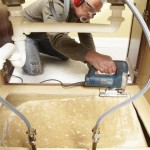Stain Stripping Kitchen Cabinets: A Comprehensive Guide
Kitchen cabinets, being the workhorses of the kitchen, often fall victim to stains and discolorations over time. Whether it's grease splatters, food spills, or simply the passage of time, these stains can detract from the beauty and functionality of your kitchen. However, with the right approach, you can effectively remove these stains and restore your cabinets to their original glory.
Understanding the Stain Types
The first step in stain stripping is to identify the type of stain you're dealing with. Different stains require different removal methods, so it's crucial to know what you're up against. Common types of cabinet stains include:
- Food and grease stains
- Water marks and rings
- Chemical burns
- Biological stains (e.g., mold)
Selecting the Right Stain Stripper
Once you know the stain type, you can choose the appropriate stain stripper. There are two main types of strippers: chemical and natural. Chemical strippers are typically more effective but require proper handling and ventilation due to their strong fumes. Natural strippers, such as vinegar or lemon juice, are safer but may not be as effective on stubborn stains.
Testing the Stripper
Before applying the stripper to your cabinets, it's always a good idea to test it on an inconspicuous area first. This will ensure that the stripper doesn't damage the finish or cause discoloration. Apply a small amount of the stripper to the test area and let it sit for a few minutes. If there is no adverse reaction, you can proceed with the stripping process.
Applying the Stain Stripper
When applying the stain stripper, follow the manufacturer's instructions carefully. Use a soft cloth or sponge to apply the stripper evenly over the stained area. Avoid over-applying, as this can damage the finish. Allow the stripper to sit for the recommended time, typically between 10 and 30 minutes.
Removing the Stripper
Once the stripper has had enough time to work, wipe it off with a clean cloth or sponge. Use warm water to rinse the area thoroughly, ensuring that all traces of the stripper are removed. Be gentle during the rinsing process to avoid damaging the finish.
Neutralizing the Area
To neutralize the area and prevent any further damage, wipe it down with a solution of 50% vinegar and 50% water. This will help to restore the pH balance of the wood and prevent the stripper from causing further harm.
Drying and Finishing
Allow the area to dry completely before applying any finishes. If necessary, use a fan or dehumidifier to speed up the drying process. Once dry, you can apply a clear sealer or topcoat to protect the finish.
Additional Tips
- Always wear gloves and a mask when using chemical strippers.
- Work in a well-ventilated area to avoid inhaling fumes.
- Don't leave the stripper on for longer than the recommended time.
- If the stain persists after the first treatment, you may need to repeat the process.
- For delicate finishes or stubborn stains, consider consulting a professional refinisher.

How To Strip And Re Stain Kitchen Cabinets Clinton Township Mi Eason Painting

How To Strip Paint Off Kitchen Cabinets And Furniture

An Easier Way To Remove Paint From Wood

Stripping Cabinets Before Painting Diy Me And Reegs

Stripping Cabinets Before Painting Diy Me And Reegs

Staining Your Wood Cabinets Darker Young House Love
:strip_icc()/103081211-6eeaaa24eefe46f9987249bf6712aa00.jpg?strip=all)
Our Step By Guide To Beautiful Stained Wood Cabinets

How To Stain Wood Cabinets True Value

How To Strip Paint Off Kitchen Cabinets And Furniture

How To Refinish Kitchen Cabinets Without Stripping Restaining Stained
Related Posts








